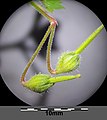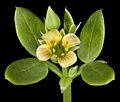Liste des noms de familles de plantes avec étymologies

Depuis la première édition de Species plantarum de Carl von Linné en 1753, les plantes se sont vu attribuer une épithète ou un nom pour leur espèce et un nom pour leur genre, un groupe d'espèces apparentées[1]. En rapport sont à leur tour regroupés en familles[2]. Le nom formel de chaque famille se termine par le suffixe latin - aceae et est dérivé du nom d'un genre qui fait ou faisait autrefois partie de la famille[3].
Le tableau en dessous contient les familles à la graine de Plants of the World par Maarten J. M. Christenhusz (l'auteur principal), Michael F. Fay and Mark W. Chase, avec deux familles actualisées [note 1] de Plants of the World Online. La deuxième colonne donne le genre typique de la famille où vient le nom de famille. La quatrième colonne donne la définition, dérivation ou personne[2].
Clé[modifier | modifier le code]
- LG : dérivé d'un mot grec (G), d'un mot latin (L), d'une autre langue (–), ou d'un nom personnel (P)
- Ba : répertorié dans The Gardener's Botanical de Ross Bayton[4]
- Bu : répertorié dans l'Index des noms de plantes éponymes de Lotte Burkhardt[5]
- CS : répertorié à la fois dans The A to Z of Plant Names d'Allen Coombes et dans le Stearn's Dictionary of Plant Names for Gardeners de William Thomas Stearn[6]
- Gl : répertorié dans The Names of Plants de David Gledhill[7]
- Qu : répertorié dans le dictionnaire mondial des noms de plantes du CRC en quatre volumes d'Umberto Quattrocchi[8],[9],[10],[11]
- St : répertorié dans le dictionnaire Stearn des noms de plantes pour les jardiniers[12]
- Les citations numériques liées dans la dernière colonne font référence à Plants of the World.
-
Acanthe ← [note 2]
-
Actinidies ←
-
Aizoon ←
-
Amarante ←
-
Ancistroclade ←
-
Aphanopétalum ←
-
Aphloie ←
-
Aster ←
-
Balanops ←
-
Bourago ←
-
Calcéolaire ←
-
Campanule ←
-
Caryocar ←
-
Cératophyllum ←
-
Cynomorium ←
-
Dasypogon ←
-
Diptérocarpe ←
-
Doryanthe ←
-
Ériocaulon ←
-
Geissolome ←
-
Fruits de géranium ←
-
Gyrostémon ←
-
Lamium ←
-
Lanaria ←
-
Fruit de Lécythis ←
-
Limnanthes ←
-
Loranthus ←
-
Graines de ménispermum ←
-
Illustration d’ Orchis ←
-
Fruit de Péra ←
-
Phyllanthus ←
-
Pittosporum ←
-
Podocarpe ←
-
Renoncule ←
-
Ripogonum ←
-
Illustration de Rubia ←
-
Sarcobate ←
-
Saxifrage ←
-
Stachyure ←
-
Staphylée ←
-
Gousses ouvertes de Stegnosperma ←
-
Stemona ←
-
Stilbé ←
-
Trochodendron ←
-
Xéronème ←
-
Zostère ←
-
Zygophyllum ←
Bibliographie[modifier | modifier le code]
À l'exception de Plants of the World, ces livres répertorient les genres par ordre alphabétique. « Nom latin de la plante » ou « Nom grec de la plante » dans la quatrième colonne signifie que le nom apparaît en latin classique ou en grec, ou les deux, pour une plante, pas nécessairement celle répertoriée ici.
- (en) Ross Bayton, The Gardener's Botanical: An Encyclopedia of Latin Plant Names, Princeton University Press, (ISBN 978-0-691-20017-0)
- (de) Lotte Burkhardt, Verzeichnis eponymischer Pflanzennamen – Erweiterte Edition, Berlin, Botanic Garden and Botanical Museum, Freie Universität Berlin, , pdf (ISBN 978-3-946292-26-5, DOI 10.3372/epolist2018, S2CID 187926901, lire en ligne)
- (en) Maarten Christenhusz, Michael Francis Fay et Mark Wayne Chase, Plants of the World: An Illustrated Encyclopedia of Vascular Plants, Chicago, Illinois, Kew Publishing and The University of Chicago Press, , 18–637 p. (ISBN 978-0-226-52292-0)
- (en) Allen Coombes, The A to Z of Plant Names: A Quick Reference Guide to 4000 Garden Plants, Portland, Oregon, Timber Press, (ISBN 978-1-60469-196-2)
- (en) Katherine E. Cullen, Biology: The People Behind the Science, New York, New York, Infobase Publishing, (ISBN 978-0-8160-7221-7, lire en ligne)
- (en) David Gledhill, The Names of Plants, New York, New York, Cambridge University Press, (ISBN 978-0-521-86645-3)
- (en) POWO, « Plants of the World Online » [archive du ], London, Royal Botanic Gardens, Kew, (consulté le )
- (en) Umberto Quattrocchi, CRC World Dictionary of Plant Names, Volume I, A–C, Boca Raton, Florida, CRC Press, (ISBN 978-0-8493-2675-2)
- (en) Umberto Quattrocchi, CRC World Dictionary of Plant Names, Volume II, D–L, Boca Raton, Florida, CRC Press, (ISBN 978-0-8493-2676-9)
- (en) Umberto Quattrocchi, CRC World Dictionary of Plant Names, Volume III, M–Q, Boca Raton, Florida, CRC Press, (1re éd. 2000) (ISBN 978-0-367-44751-9)
- (en) Umberto Quattrocchi, CRC World Dictionary of Plant Names, Volume IV, R–Z, Boca Raton, Florida, CRC Press, (1re éd. 2000) (ISBN 978-0-367-44750-2)
- (en) William Stearn, Stearn's Dictionary of Plant Names for Gardeners, London, Cassell, (ISBN 978-0-304-36469-5)
- (en) International Code of Nomenclature for algae, fungi, and plants (Shenzhen Code) adopted by the Nineteenth International Botanical Congress Shenzhen, China, July 2017, Glashütten, International Association for Plant Taxonomy (lire en ligne)
- (en) Roland Brown, Composition of Scientific Words, Washington, DC, Smithsonian Institution Press, (ISBN 978-1-56098-848-9)
- (en) Charlton Lewis, An Elementary Latin Dictionary, Oxford, Oxford University Press, (ISBN 978-0-19-910205-1, lire en ligne).
- (en) Henry George Liddell et Robert Scott, An Intermediate Greek–English Lexicon, Mansfield Centre, Connecticut, Martino Fine Books, (1re éd. 1888/1889) (ISBN 978-1-61427-397-4, lire en ligne).
Notes et références[modifier | modifier le code]
Notes[modifier | modifier le code]
- (en) Cet article est partiellement ou en totalité issu de l’article de Wikipédia en anglais intitulé « List of plant family names with etymologies » (voir la liste des auteurs).
- Calceolariaceae et Viburnaceae
- Les flèches fournissent un lien vers la ligne du tableau pour le genre donné
Références[modifier | modifier le code]
- Cullen, p. 38.
- Christenhusz, p. 14.
- ICN, art. 18.
- Bayton.
- Burkhardt.
- Coombes.
- Gledhill.
- Quattrocchi1.
- Quattrocchi2.
- Quattrocchi3.
- Quattrocchi4.
- Stearn.
















































